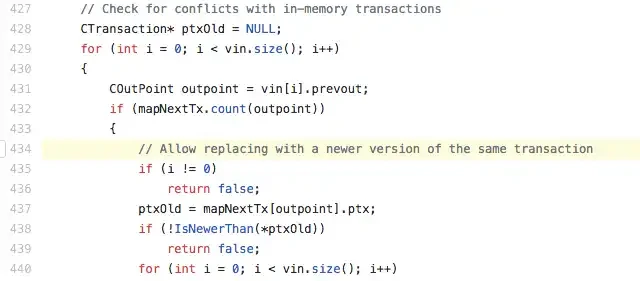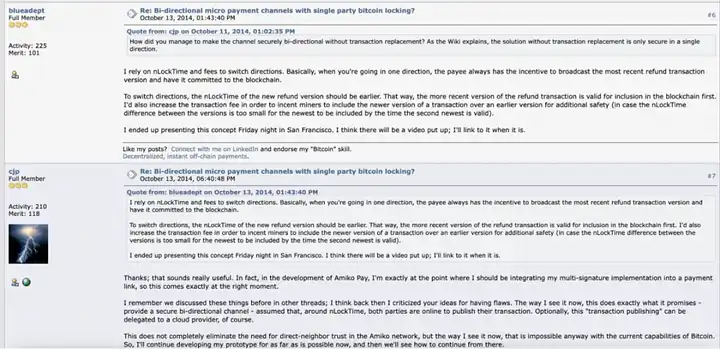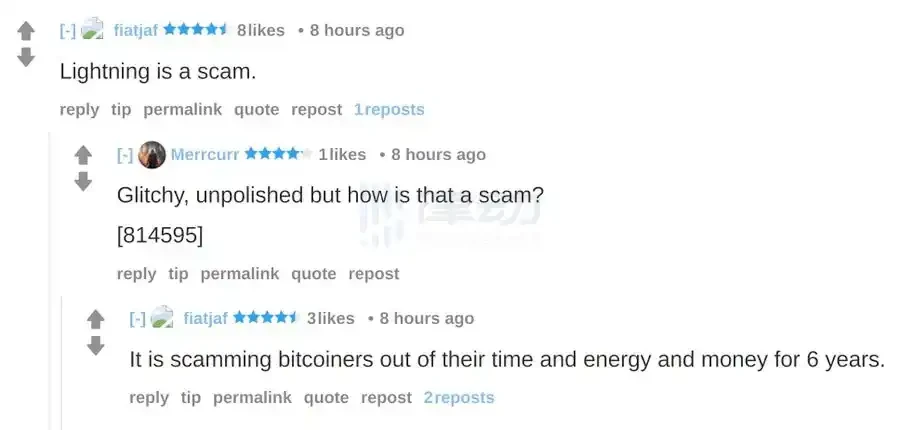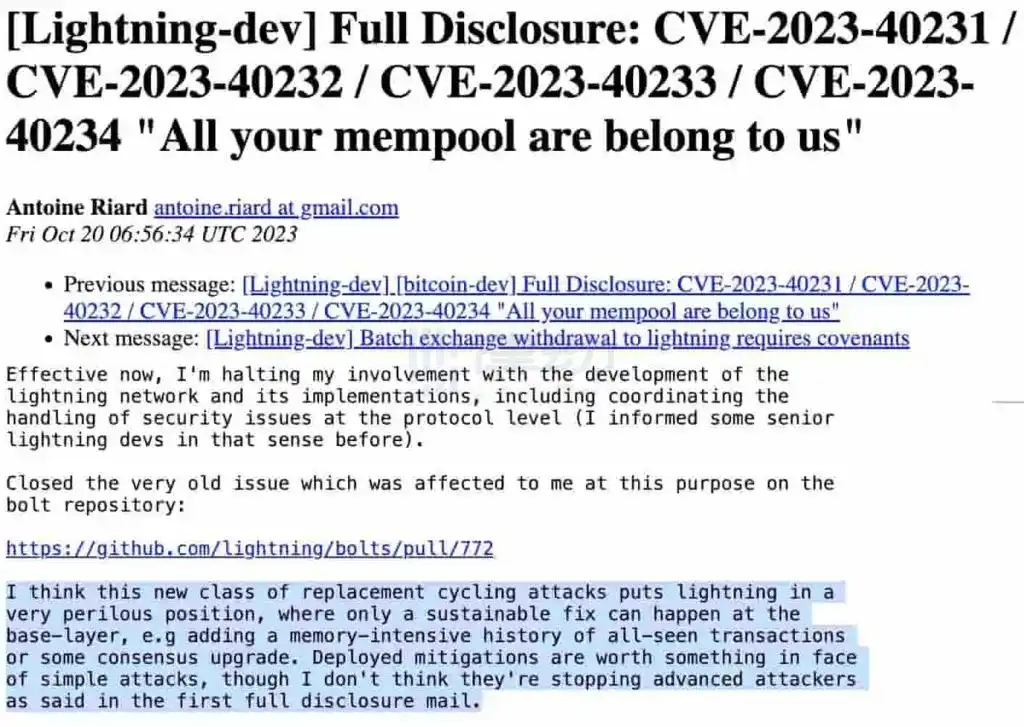Original author: Jaleel, Luccy, BlockBeats
Original editor: Jack, BlockBeats
In the crypto community, "orthodoxy" is one of the most frequently used terms in the past two years. Although this term was first used in Ethereum (Vitalik wrote a blog post in March 2021 titled "Orthodoxy is the Scarcest Resource in the Crypto Ecosystem" to explain the concept of orthodoxy), it is also prevalent in the Bitcoin community. For most people, the "orthodox son" of the Bitcoin community is the Lightning Network.
Amid the rising concept of the "Bitcoin ecosystem," various Bitcoin scaling solutions such as sidechains and virtual machines have entered the investors' field of vision. However, the mainstream view of the Lightning Network in the market seems to still be stuck in the "payment channel" phase. As the Bitcoin ecosystem continues to develop, the Lightning Network is beginning to face "transformation pressure." This article outlines the origins of the Lightning Network, its two main development entities, and explains the challenges it currently faces and its future development direction.
Satoshi Nakamoto's Email
When it comes to Bitcoin, the Lightning Network is definitely a key term that cannot be bypassed.
In the early years, the public had little understanding of Bitcoin, and there were not as many Bitcoin evangelists, so the only way to get a clear answer was to directly ask Satoshi Nakamoto. In 2011, software developer Mike Hearn, who was a senior software engineer and technical lead at Google, also devoted much of his energy to Bitcoin development. Over about five years of Bitcoin development, Mike Hearn had various conversations with Satoshi Nakamoto via email, and later published them as historically significant documents on his blog.
On March 7, 2011, just after releasing BitCoinJ (an open-source Bitcoin client library built and implemented in Java) under the Apache 2 license on behalf of Google, Mike Hearn was preparing to complete the implementation of the full client mode in the next one or two months.
He emailed Satoshi Nakamoto, asking, "I still don't fully understand why the sequence number is an attribute of the TX input, not the TX itself?"

In response, Satoshi Nakamoto said, "Intermediate transaction doesn't need to be broadcast, only the final result will be recorded by the network. Just before nLockTime, parties and some witness nodes broadcast the highest sequence tx they saw." This is Satoshi Nakamoto's explanation of the payment channel, and it is also the embryonic form of the Lightning Network, the birth of its orthodoxy.
If we were to trace back even further, Bitcoin 0.1 contained a code draft that allowed users to update the transaction before it was confirmed by the network.

Payment channel draft included in Bitcoin 0.1. Source: GitHub Lightning Network stakeholders: Blockstream and Lightning Labs
The design of payment channels and networks has evolved over the years, and the development gradually became clear after the release of the Bitcoin Lightning Network whitepaper in early 2015. Unexpectedly, in the following months, the entire spring and summer of 2015, the debate over Bitcoin's expansion issues and block size limits became a public dispute.
In December 2015, Gregory Maxwell (one of the founders of Blockstream) proposed an expansion plan roadmap in a Bitcoin developer email, which included a focus on the Lightning Network. Most of the Bitcoin technical community expressed support for increasing the Bitcoin system's capacity and implemented it in the Bitcoin Core project. This unexpectedly raised expectations for the Lightning Network. The subsequent debate over Bitcoin's expansion unexpectedly pushed the Lightning Network into the spotlight.
The "Bitcoin Giant" Blockstream
There has always been a rumor in the community that Blockstream is the "stakeholder" behind Bitcoin. This rumor is not groundless.
On October 23, 2014, Blockstream, one of the most influential companies in building the Lightning Network, was founded. Adam Back, the inventor of hashcash, gathered a group of Bitcoin developers including Matt Corallo, Greg Maxwell, and Pieter Wuille to establish the Blockstream company and released their sidechain whitepaper.
Since its establishment, Blockstream has been a pioneer in developing the Lightning Network. As the founder of Blockstream, Adam Back's influence is not to be underestimated. In a foreign "cryptocurrency" influence ranking, Adam Back ranks fourth, with the top three being: Andreas Antonopoulos (early Bitcoin evangelist), Vitalik Buterin (Ethereum founder), and Nick Szabo (proposer of the "smart contract" concept).

Foreign "cryptocurrency" influence ranking
The reason for Adam Back's significant influence can be traced back to 1997. At that time, the Internet was just emerging, and email was considered the first application for people to communicate. However, a large amount of spam emails caused a lot of trouble, and many people began to try to find a solution. Adam Back published an email titled "A partial hash collision based postage scheme," in which he introduced Hashcash, a mechanism using a technique called proof of work to prevent spam emails. Therefore, Adam Back is also often referred to as the "father of PoW."
All of this, because Satoshi Nakamoto mentioned Adam Back's "Hashcash" in the Bitcoin whitepaper, made him known and gradually established his strong position in the crypto industry.

Among the founding members and major contributors of Blockstream, there are also key members of the Bitcoin development team, such as Greg Maxwell and Pieter Wuille.
Greg Maxwell, a renowned cryptographer and software engineer, has made significant contributions to Bitcoin's privacy and scalability. For example, he contributed to the use of homomorphic key derivation in BIP32, as well as to privacy protection technologies such as CoinJoin and blind proofs. Since May 2011, Pieter Wuille has been a Bitcoin Core developer. In 2012, Wuille released BIP 32, which added hierarchical deterministic wallets to Bitcoin, and also contributed to the development of key technologies such as Segregated Witness (SegWit).
While theoretically anyone can contribute code to the BTC Core project, only those with commit access can merge the code into the actual BTC protocol. Pieter Wuille was one of the only five people with commit access to the BTC code repository at the time, and he contributed the most code to the BTC project after Satoshi Nakamoto.
In late 2015, amid the heated discussions in the Bitcoin community about scaling, a paper titled "A Fast and Scalable Payment Network with Bitcoin Duplex Micropayment Channels" was published by researchers at ETH Zurich. The solution proposed in this paper heavily relied on time locks as a "countdown device" for channel validity, as well as a cryptographic technique called "invalid tree" to invalidate outdated channel transactions. This became the technical prototype on which the Lightning Network relied. The two authors of this paper, Christian Decker and Roger Wattenhofer, later joined Blockstream.
Unexpectedly, in the following months, and even the entire spring and summer of 2015, the debate over Bitcoin's expansion issues and block size limits became a public dispute. On August 15, 2015, two early Bitcoin pioneers, Gavin Andresen and Mike Hearn, jointly announced in a blog post that their new version of BitcoinXT would implement the BIP-101 proposal without the need for miner voting, and it would be activated directly. This day, later referred to as the "block size war outbreak day," saw significant contributions from Blockstream to promote the Lightning Network.
In December 2015, Gregory Maxwell, one of the founders of Blockstream, proposed an expansion plan roadmap in a Bitcoin developer email, which included the Lightning Network as a key component. Most of the Bitcoin technical community expressed support for increasing the Bitcoin system's capacity and implemented it in the Bitcoin Core project. This sparked high expectations for the Lightning Network.
At the time, there were two completely different views on the dispute between the Bitcoin Core development team and Bitmain.
On one hand, Bitmain's supporters believed that the Bitcoin Core development team was a group of stubborn programmers who adhered to the original Bitcoin core and refused necessary changes and adaptations. They believed that these developers were immersed in their own technical world, ignoring the true needs of Bitcoin's development, and were hindering progress as "old guys." On the other hand, supporters of the Bitcoin Core development team believed that Bitmain was using its influence and information advantage in the industry to deliberately distort facts, mislead the public and miners.
Adam Back, co-founder of Blockstream, represented Bitcoin developers and mediators between the two sides, and attended the Consensus Conference in Hong Kong. As one of the earliest blockchain development companies, Blockstream not only had personnel intersections with Bitcoin Core, but also funded their development work. Adam Back's signature led people to believe that the developers had agreed to the Hong Kong Consensus.

However, after the conference, Bitcoin Core stated that the developers who had promised various changes at the meeting were all programmers without Core source code modification permissions. None of the five people with the right to modify the Core source code attended, let alone signed.
Adam Back also stated that his signature at the conference only represented himself and could not represent Bitcoin Core's agreement to the Hong Kong Consensus. His attitude directly turned 180 degrees, strongly opposing the Hong Kong Consensus that he had recently signed. The Hong Kong Consensus was rejected by Bitcoin Core, but at the same time, the Lightning Network received "orthodoxy" consensus from Bitcoin developers.
In the summer of 2017, Segregated Witness (SegWit) was activated on the Bitcoin blockchain, paving the way for the implementation of the Lightning Network. It can be said that Greg Maxwell and Pieter Wuille played crucial roles in the upgrade of the Bitcoin network, especially in the introduction of Segregated Witness (SegWit) and the development of the Lightning Network.
Due to Blockstream employing a large number of Bitcoin Core developers, the company had significant influence on Bitcoin development, which attracted a lot of criticism. For example, some people said that Blockstream actually controlled Bitcoin's development (some even said that Blockstream used water armies in the Bitcoin community to suppress opponents, control public opinion). According to Whale Calls' analysis, 12%-20% of the updates to the Bitcoin code came from Blockstream developers.
A few years ago, most analyses of Adam Back in the community were that he wanted to profit from Bitcoin. This was because Blockstream's business model was to sell sidechain/Lightning Network product services, and if the block size were to be increased, sidechain/Lightning Network would become useless, and as a profit-oriented company, Blockstream would not be able to generate revenue.
Lightning Labs: The Lightning Network Whitepaper Authors Go Their Separate Ways
The greatest orthodoxy of Lightning Labs perhaps comes from its founders, the authors of the Lightning Network whitepaper, Joseph Poon and Tadge Dryja.
In the fall of 2015, this San Francisco-based startup, led by Elizabeth Stark, brought together the two co-authors of the Lightning Network whitepaper, Joseph Poon and Tadge Dryja, to start a business, standing on equal footing with Blockstream. The main difference between the two is that Lightning Labs uses the Go programming language, while Blockstream uses the C programming language.
Lightning Labs not only made critical contributions to the theoretical foundation of the Lightning Network but also released the beta version of the Lightning Network in March 2018, marking an important milestone in the development of the Lightning Network.
The early team of Lightning Labs was no less competitive than Blockstream.
Before writing the Lightning Network whitepaper, Dryja founded the peer-to-peer transaction system mirro and introduced the concept of prediction markets. He also researched a PoW algorithm called Hashimoto, which was the precursor to the Dagger Hashimoto algorithm, an alternative algorithm before the launch of the Ethereum PoW algorithm ethash.
Apart from Dryja, the other author of the Lightning Network whitepaper, Poon, is also a top developer in the crypto industry. For example, the recent article by Vitalik supporting the return of Plasma is in support of the second-layer scaling technology for Ethereum that Poon and Dryja jointly launched in 2017. They are strong partners dedicated to scalability projects. Additionally, Poon has also worked on a project called Handshake, which inherits the ideas of Namecoin.
Elizabeth Stark, as the co-founder and CEO of Lightning Labs, is highly respected in the cryptocurrency and open internet fields. She is a well-known entrepreneur and educator with significant influence in the Bitcoin community.
Olaoluwa Osuntokun (Roasbeef), another co-founder of Lightning Labs, is also an outstanding Bitcoin developer who has made important contributions to the development of the Lightning Network. He developed the LBD protocol based on the LIT protocol, which gained recognition from more developers.
Among the engineers at Lightning Labs, Alex Akselrod is worth mentioning. Four months before the release of the Lightning Network whitepaper, Akselrod first proposed the concept of bidirectional payment channels. The core idea was to introduce decrementing time locks, allowing the receiver to send funds to the sender a limited number of times. Alex Bosworth also made the first transaction on the Lightning Network by paying his phone bill through a Lightning channel established with Bitrefill.

Image Source: https://bitcointalk.org/index.php?topic=814770.msg9185225#msg9185225
However, at the end of 2016, just one year after the founding of this Lightning Network company, the two authors of the Lightning Network whitepaper split due to a "dispute."
When joining Lightning Labs, Dryja developed the first version of the protocol called LIT, which was not compatible with BOLT developed by Blockstream. However, Lightning Labs' CTO, Olaoluwa, developed the LND protocol, which was compatible with BOLT and gradually gained more recognition, eventually surpassing the former.
As a result, Lightning Labs decided to focus on LND, while Dryja chose to leave Lightning Labs and join the research community at the MIT Media Lab to continue developing Lit. Interestingly, this research community also employed top Bitcoin Core developer Wladimir van der Laan and several contributors to Bitcoin Core.
Thus, the two authors of the Lightning Network whitepaper, Joseph Poon and Tadge Dryja, went their separate ways.
Although Lightning Labs lost Tadge Dryja, it gained the support of Jack Dorsey. After leaving Twitter, Jack Dorsey actively promoted Bitcoin and the Lightning Network through his company, Block Inc. (formerly Square Inc.).
In 2018, Dorsey participated in Lightning Labs' seed round financing, and in 2022, he participated in Lightning Labs' $10 million Series A financing, aiming to support the development of a Bitcoin Visa network. It can be said that a series of developments and advancements by Lightning Labs are closely related to the former CEO of Twitter, Jack Dorsey.
Subsequently, Square's project under Square Crypto was renamed Spiral and developed the Lightning Development Kit (LDK), which allows developers to integrate Lightning Network transactions into mobile devices and point-of-sale terminals. In addition, Square launched the mobile payment solution Cash App, which integrated the Lightning Network.
In addition to Jack Dorsey, notable investors and institutions in Lightning Labs include Digital Currency Group, Robinhood, Ripple's Xpring, former global co-founder Howard Morgan, Goldman Sachs executive John Pfeffer (formerly of KKR), and Forbes 30 Under 30 personality Jill Carlson.
Subsequently, there has been a gradual enrichment of protocols and applications related to the Lightning Network, such as the enhanced version of the BOLT protocol—OmniBOLT, and payment platforms that support Bitcoin Lightning Network, such as Cash App and Strike.
Although several teams have started developing the Lightning Network, the contributions of Blockstream and Lightning Labs are the most significant. In the evolutionary history of the orthodoxy of the Lightning Network, their roles are not to be underestimated.
Under the Push of Blockstream and Lightning Labs, Over the years, there have only been two scaling solutions for Bitcoin: the Lightning Network and others.
The Crossroads of the Lightning Network
Despite having absolute orthodoxy in recent years, it is clear that in the past year, there have been increasingly more voices denying the Lightning Network, especially among some senior developers.
"Fiatjaf, founder of Nostr, said, 'The Lightning Network has been deceiving Bitcoin users for time, energy, and money for 6 years.'" It can be said that in the past two months, there has been an escalating debate about the Bitcoin Lightning Network. Recently, at least two developers have announced their withdrawal from work related to the Lightning Network.

Developers Continue to Leave
On October 16, Lightning Network security researcher and developer Antoine Riard discussed in depth the funding loss risks faced by Lightning Network channels in an email, mainly due to the problem of replacement loop attacks in the transaction pool. He specifically mentioned a type of transaction relay interference attack that affects Lightning Network channels, which is entirely possible in practice, even without network transaction pool congestion.
Riard also stated that he will stop participating in the development of the Lightning Network from now on because this new replacement loop attack would put the Lightning Network in a very dangerous position. However, from an optimistic perspective, this attack is highly complex and not easy to execute.

Two weeks after Antoine Riard announced his departure, on October 30th, Anton Kumaigorodski, the developer of the first mobile Lightning wallet, also announced his resignation on Nostr. Anton Kumaigorodski is the developer of the Bitcoin Lightning Wallet (BLW) and Simple Bitcoin Wallet (SBW). Additionally, he developed the Scala IMMORTAN library, which allows the construction of mobile-optimized applications on top of Lightning Network clients. Unlike many critics of the Lightning Network, he is fully aware of why LN as a technology remains challenging. His three reasons for leaving are:
Serious Lightning Network development is both difficult and time-consuming. The entire Lightning Network protocol is overly complex and getting worse, with only a very small number of well-known experts able to develop at a very slow pace. Philosophically, I believe that Bitcoin as a protocol should have a complexity barrier so that it does not exceed the point where outsiders cannot understand and trust it. I believe the Lightning Network has passed this barrier.
After more than 6 years of struggle, the Lightning Network has transcended a community primarily composed of ideological users, without clear success or viewpoints. My view is that ultimately the Lightning Network is not the expectation of the entire market for Bitcoin. People should look for other directions instead of focusing excessively on the Lightning Network, apart from foolish payments.
The remaining demand for the Lightning Network is mainly absorbed by various custodial solutions. In terms of user experience, a truly non-custodial Lightning Network wallet is always worse than a custodial wallet. Throughout history, we have seen that most remaining users always choose convenience over control. This makes developing non-custodial Lightning Network solutions for end users feel like the most thankless task in the world.
Bitcoin researcher and developer Robin Linus, after receiving great attention for his "BitVM" paper, added, "It's time to admit that we oversold the Lightning Network to each other, perhaps as a form of post-traumatic stress disorder after the block size war. It's time to overcome it. The Lightning Network doesn't work for the masses."
Alexander Leishman, CEO and CTO of River, also pointed out the user experience (UX) challenges of self-custody in the Lightning Network, stating, "The Lightning Network is very well suited for custodial-to-custodial transfers. The Lightning Network presents huge user experience challenges for consumer self-custody." He emphasized the difficulties that ordinary users face in managing their Lightning Network transactions.
In fact, the potential scalability limitations of the Lightning Network were already evident in the early stages of its development, as mentioned in the Lightning Network whitepaper, especially regarding the potential lack of support for the soft forks needed in the future, which was seen as a potential constraint on the scalability of the Lightning Network.
In this context, what are the plans of the two main Lightning Network companies, Blockstream and Lightning Labs?
Pressure from Sidechains
In addition to the Lightning Network, Blockstream's focus in recent years has been on the sidechain product Liquid Network.
In 2014, a paper titled "Enabling Blockchain Innovations with Pegged Sidechains" was published by Adam Back, Matt Corallo, Luke-Jr, and others. This paper first publicly proposed the concept of driving blockchain innovation through pegged sidechains.
On October 12, 2015, Blockstream announced the release of its Liquid sidechain prototype, which allows the transfer of assets between the Liquid sidechain and the Bitcoin main chain. On October 11, 2018, the production-ready version of the Liquid sidechain was officially launched, called the Liquid Network, aimed at promoting interoperability between the Bitcoin main chain and the Liquid sidechain to expand the functionality of Bitcoin.
The sidechain concept, born from Adam Back's paper, is not limited to just Liquid; there is also Drivechain.
In a blog post in 2015, Paul Sztorc, co-founder of LayerTwoLabs, further introduced the concept of Drivechain, proposing it as a method to avoid hard forks caused by consensus disagreements, thus preventing the fragmentation of Bitcoin. Drivechain introduced an innovative way for Bitcoin to create and delete sidechains and to send and receive BTC on the so-called "second layer" - the sidechain. Bitcoin and Drivechain form a parent-child relationship, with Bitcoin as the parent and Drivechain as the child, so Drivechain itself does not issue native tokens. Instead, it relies entirely on BTC transferred from the Bitcoin network.
Drivechains create and rely on the concept of blind merged mining, allowing miners on the Bitcoin blockchain (parent) to mine on the Drivechain (child) without running a full Drivechain node, and miners are paid in BTC. In 2017, Paul Sztorc proposed Bitcoin Improvement Proposals BIP 300 and 301, allowing the creation of sidechains associated with the Bitcoin mainnet but with independent rules and functions.
Adam Back expressed appreciation for this form of sidechain, stating, "Kudos to Paul Sztorc and his team for implementing and validating the Drivechain design." He also believed that Drivechains are cool and may be more important or useful than Taproot. He mentioned, "I think we will need a large P2P sidechain to benefit the next billion users from non-confiscatable, censorship-resistant #bitcoin. Supporting P2P sidechains operations, such as LayerTwoLabs' Drivechain, P2P's Liquidium, Rootstock."
It is worth noting that LayerTwoLabs, led by Yale economist Paul Sztorc, was co-developed by Bitcoin developers CryptAxe (2016-present) and Luke Dashjr (2012-present). Luke Dashjr is the Bitcoin Core developer who recently criticized Bitcoin's inscription. On August 22, he submitted a PR for BIP300 to the Bitcoin Core Github code repository, and the Bitcoin Core community began reviewing the Drivechain-related code.
LayerTwoLabs aims to promote major upgrade proposals BIP300 and BIP301 for Bitcoin, using DriveChain to make Bitcoin highly scalable, private, and with better UX, while supporting the development of multiple sidechains. The goal is to introduce decentralized applications and other expanded functions of blockchain into the Bitcoin ecosystem for its long-term healthy development. LayerTwoLabs has completed a $4 million angel round of financing and is currently undergoing the next round of financing.
Prominent figures such as the inventor of BitVM, Robin Linus, Fiatjaf, founder of Nostr, and Anton Kumaigorodski, while "letting go" of the Lightning Network, have expressed varying degrees of support for Drivechain.
Although Drivechain has received support from many Bitcoin OGs, there may still be a long way to go before it can be implemented on a large scale through BIP proposals. "Optimistically, it may take one or two years, pessimistically, it may take three or four years," said Mike Yeung, an investor and Asia Pacific head of the Drivechain development team LayerTwoLabs, to BlockBeats. Launching Drivechain is undoubtedly a daunting task, but LayerTwo Labs has some plans and strategies to accelerate the adoption of Drivechain technology.
From a technical perspective, Mike Yeung believes that the Lightning Network has some security vulnerabilities. Additionally, the Lightning Network is not beneficial to miners, and in fact, the relationship between the Lightning Network and miners is not good. As for the possibility of the Lightning Network as a scaling tool, "I think it's actually impossible because it cannot implement smart contracts, and its capabilities are very limited. I don't think the Lightning Network will completely fail, but its prospects are not optimistic."
"Since 2017, countless investors, including individual investors, family offices, and venture capitalists, have invested in the Lightning Network, and they cannot let their investments go to zero," said Mike Yeung to BlockBeats. At the same time, some influential figures, including the former CEO of Twitter and the leadership of MicroStrategy, have closely associated their public image and public relations strategy with the Lightning Network brand. Due to their previous public support and the nature of their companies, they find it difficult to retract their previous statements. This has led them to continue promoting the advantages of the Lightning Network, despite recognizing its limitations and the fact that it may not be the ultimate solution to Bitcoin's scalability issues.
Attempting to Break Through
Blockstream focuses on mainchain and sidechain research, while Taproot Assets is dedicated to developing Lightning Labs into a multi-asset network.
Taproot Assets is a CSV asset protocol based on Taproot for issuing assets on the Bitcoin blockchain. These assets can be traded instantly, in large quantities, and at low cost through the Lightning Network. The core of Taproot Assets is to leverage the security and stability of Bitcoin, as well as the speed, scalability, and low cost of the Lightning Network.
This concept began in 2021 when the Lightning Labs team discovered that Bitcoin had achieved national-level application in El Salvador through the Lightning Network. This realization led Lightning Labs CEO Elizabeth Stark to understand that the focus of attention was gradually shifting from Bitcoin assets to Bitcoin's monetary network. The team began to envision a multi-asset network aimed at expanding the global influence of Bitcoin and Lightning.
In September 2022, Lightning Labs released the initial Taro protocol code and announced a $70 million financing. However, due to allegations from the blockchain startup Tari Labs that the name Taro was similar to its own trademark and provided similar services, Taro was renamed Taproot Assets.
Lightning Labs designed a new protocol to avoid blockchain congestion, which was also the original intention of Taro. It is closely integrated with the Lightning Network, allowing assets to be stored and transferred in Lightning channels, enabling instant, low-cost transactions. Another consideration is the overwhelming demand for stablecoins from users and Lightning Labs' goal of "Bitcoinizing the dollar."
With Taproot Assets using Bitcoin liquidity to route assets issued on the protocol, the demand for Bitcoin on the Lightning Network will be even greater. As a result, Bitcoin will circulate everything from dollars and fiat currencies to everything in between, achieving the Bitcoinization of the dollar. The ultimate goal of the Lightning Network is very clear: after the release of Taproot Assets, it will focus on developing into a multi-asset network.
In the development of the test network over the past few months, early adopters and the team have iterated continuously, minting nearly 2,000 assets on the test network, exploring the potential of stablecoins, collectibles, and real-world asset (RWA) assets, and synchronizing their nodes with the Universe server, a repository that stores all the information needed for wallet initialization and wallet state downloads.
Taproot Assets is designed and developed by Olaoluwa Osuntokun, co-founder and CTO of Lightning Labs. Olaoluwa Osuntokun is one of the main developers of the Lightning Network client LND and a contributor to the Bitcoin client (BTCD). He is one of the few developers who has worked on both the Lightning Network and Bitcoin clients, and has a deep understanding of Bitcoin.
The Entrepreneurial Spirit of Bitcoin
Unlike Ethereum, Bitcoin's "rigidity" is the foundation of its orthodoxy. This "rigid" culture emphasizes decentralization, freedom, security, and privacy, but it has also nurtured a fair and diverse culture and technical community.
"If you have attended Bitcoin and Lightning Network conferences, it is easy to see the differences between the two communities," said Antoine Riard in his blog post, evaluating the Bitcoin developer community. Bitcoin conferences (mainly for Bitcoin Core) typically focus on in-depth technical discussions, emphasizing security and protocol engineering, with participants including experienced internet users, various hackers, and civil libertarians. After countless scams, they naturally maintain a skeptical attitude, but intellectual debates remain open and honest.
In contrast, the Lightning Network community feels different. They are usually younger, more entrepreneurial, and focus more on user experience and product design. The venue is vibrant, with many dazzling Lightning applications for everyone to experience, and the influence of Silicon Valley is evident here. This is also evident in the Lightning Torch Relay event.
Compared to Bitcoin Core, the Lightning Network places more emphasis on innovation, practicality, and a spirit of community collaboration. This cultural difference reflects the diversity and complexity of the Bitcoin ecosystem, as well as the source of its charm and vitality.
In the new context of the "Bitcoin ecosystem," inscriptions and memes abound, but when the tide recedes, what will be left of this ecosystem? The author believes that the culture of Bitcoin, as well as more entrepreneurial communities and teams, will be a valuable asset for the development of the Bitcoin network.
Author's Note: This article attempts to summarize the origin story of the Lightning Network and its impact today, but the history of the Lightning Network is much richer than I know, and putting it all in one article structure would require omitting many details and would not reflect all the people, projects, and concepts that have helped to achieve this technology. It is best to consider this article as a rough summary rather than a detailed history and technical explanation. Thanks to all the friends who provided information and other feedback.
References:
"THE HISTORY OF LIGHTNING: FROM BRAINSTORM TO BETA", by Aaron Van Wirdum;
"The Past of Bitcoin Forks", by BlockBeats;
"Why we may fail Lightning", by Antoine Riard;
"The joyful journey of building Bitcoin", by Antoine Riard;
"Co-founder of Lightning Labs: Taproot Assets can bring 'Bitcoin Renaissance'", by BlockBeats;
免责声明:本文章仅代表作者个人观点,不代表本平台的立场和观点。本文章仅供信息分享,不构成对任何人的任何投资建议。用户与作者之间的任何争议,与本平台无关。如网页中刊载的文章或图片涉及侵权,请提供相关的权利证明和身份证明发送邮件到support@aicoin.com,本平台相关工作人员将会进行核查。




